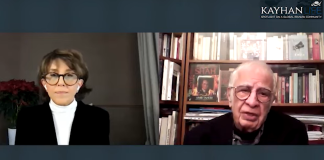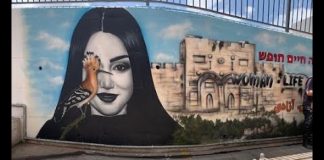Born in Stockholm, Sweden in 1960, Ingrid Leksand (not the author’s real name) moved to the UK with her family when she was five years old. Her father was an engineer whose company was involved in development projects in Iran. They left Iran at the time of the 1978-79 revolution.
“I spent a good few years of my teenage years in Iran, and was forced to leave because of the revolution,” Leksand said in an interview with Kayhan Life. “I have wanted to write my story from the day I left Iran. I have lived with the nostalgia of Iran for the past 40 years.”
“From Fall to Spring” tells the story of Pedram Azad, an Iranian English-language teacher living and working in Tabriz, Iran between 1974 and 1983. It portrays the daily life and concerns of young, upwardly mobile and educated Iranians before the 1978-79 revolution, and reaches as far back as 1904. It traces the hopes, tragedies and yearning for survival of two generations of Iranians.
The book is a melange of stories inspired by the lives of Leksand’s Iranian friends. She sought permission to tell their tales, and changed the characters’ names to protect personal identities.
The book’s principal characters include Madar, a grandmother who was one of the very first female teachers in one of Iran’s first girls’ schools. Another is Pedram’s tender love, Armineh, an Iranian-Armenian wanting to improve the justice system and especially its treatment of women. Among the subjects tackled in the book is that of sexual identity and relationships in Iran.
The following is a Kayhan Life interview with the author.
Why did you write this book?
To portray an image of Iran away from the daily politics that we have seen on our TV sets for the past 40 years. I was young when I left Iran. The Iran I remember was one where anyone looked for any opportunity to have a good time. I wanted to show the world that the Iranians that I knew and lived with had a normal everyday life away from politics.
In today’s media, all we see from Iran is women in chadors chanting death to America, or other unattractive, unsavoury images. I feel it’s not helpful for the new generation of Europeans to have this one-dimensional picture of the Iranian people. As someone who lived in Iran all those years, I feel I have a responsibility to provide a richer perception of Iran. By Iran, I mean the Iranian people.
What are some of the issues that you tackle in the book?
One is women’s rights. I addressed this through the stories and experiences recounted by the main character’s grandmother. Through the stories and expression of Pedram and his friends, I wanted to convey the vibrancy of society, and how it was easy for them to achieve their professional goals, thanks to the opportunities that existed at that time. I wanted to highlight the women’s liberation movement. I wanted to show it through the older generation who had moved on and appreciated what they had gained during the Pahlavi dynasty.
Some characters in the novel leave Iran, whereas others decide to stay. I also wanted to show the building of friendships and relationships over and beyond individual differences — be they generational, political, religious or even linked to sexual orientation.
Who is your audience?
The primary target audience is non-Iranians. Through the use of press cuttings from the international media, I wanted to provide them with a Western perspective of Iran, of how positive it was up to the revolution. If you compare those cuttings, you’ll see a curve: how at the start it was all about progress, economic development and cultural events, and how suddenly things changed after the revolution into chaos and nightmare.
The book is the story of ordinary middle-class families who love to get together, have a good time, eat delicious food and party. They are not as politicized as Iranians are today.
Pedram and his grandmother are both teachers. Pedram is in his late 20s. He was brought up by his grandmother. I chose two different generations to trace the span of Iran’s history.
Your book also coincides with the teachers’ strikes recently. Why did you use teachers as your main characters?
I have been following the news coming out of Iran since the pro-democracy protests began in late 2017. Teachers have played an important part in this movement. Many protests and strikes have been led by the teachers. While I was researching the book, I discovered through an English friend who was a teacher in the 1970s that her income was far less than the income of Iranian teachers. I also remember that in the 1970s, many Iranians achieved a level of income that allowed them to travel abroad for holiday, but complained without realizing how far the country had come in such a short span of time and how much they were better off than in most Western countries.
How long did it take you to write this book?
The first draft of the book took six months. But it took me over two years to edit it, to ensure its historical and chronological accuracy.
[aesop_image img=”https://kayhanlife.com/wp-content/uploads/2020/01/dfw-il-ffts-cover-wrap-1-scaled.jpg” panorama=”off” align=”center” lightbox=”on” captionsrc=”custom” captionposition=”left” revealfx=”off” overlay_revealfx=”off”]







